Trips Into History visits some of the old California theaters, many of which trace their beginnings back to the days of the Gold Rush. Several of these theaters are still standing and make great additions to your California vacation planner.
Thank you for reading this post, don't forget to subscribe!
Interestingly enough, the theaters not only sprouted up to offer some type of “refined” entertainment to the gold prospectors, but in places like San Francisco, even warred against each other to compete for the money and gold streaming into that city.
Add These Sites to Your California Trip Planner
Nevada Theater– Located in Nevada City California up in the Sierra Nevada this is the oldest continuously operating live theater in California. Nevada City was at one time a booming mining town and attracted as performers such notable names as the Lotta Crabtree, Edwin Booth and Mark Twain.
Eagle Theater– This reconstructed theater is located in Old Town Sacramento California. The original theater which was built with canvas and wood was washed away by a flood in January 1850 just three months after it’s construction. The story is that Gold Rush miners attended live performances even while the theater was being filled with water. Eventually it collapsed and floated down the Sacramento River.
Napa Valley Opera House– This opera house opened in Napa California in 1880. The Italianate style building was the venue for the 1896 exhibition featuring the famous fighter, John L. Sullivan. The writer Jack London also read from his works at the opera house.
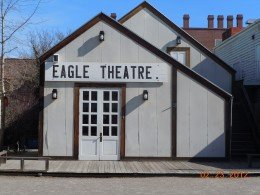
Live Theater and the Gold Miner
The first entertainers to reach the remote mining camps in the Sierra Nevada foothills might be someone with a guitar and a song. Nothing spectacular. The venue might have been a saloon and a tent saloon at that. These were really traveling shows. What was realized by the traveling minstrels was that a prospector would gladly pay for entertainment. The San Francisco theater business was right around the corner. The gold rush of 1849 was soon to enrich the city in another way.
Men of means in San Francisco discovered that there was another way, in addition to gambling, to part miners from their gold nuggets. The 49ers gold rush was soon to pour more gold into San Francisco. Live entertainment was just the thing for home sick prospectors. Women at this early year were essentially absent. There was no Saturday night courting. The miners would gladly pay to be entertained and especially entertained with something comical or slapstick. A form of entertainment that would get their thoughts away from the drudgery of mining for gold. The wilder and funnier the better.

In the book Women of the Gold Rush by author Elizabeth Margo, she states that California’s very first concert was performed on June 22, 1849 in San Francisco. The venue was a small schoolhouse located on the plaza which also doubled as a jail. The entertainer was a man named Steve Massett who was a part songwriter and piano player. All reports were that the concert was sold out (in a very small structure) and was accepted well. As it turned out, this was a one time event and things on the theater front were quiet until the end of 1849.
In the winter of 1850, a man referred to as the Doctor, would open San Francisco’s first theater, although using the word theater is a bit of a stretch. A hastily put up shack was a better description. The Doctor, also going by the name of Yankee Robinson, was indeed a doctor who had a medical school degree from the east. Yankee Robinson operated a drug store on the plaza and also had a talent for performing. Robinson was a part mimic, songwriter, guitar player and monologist.
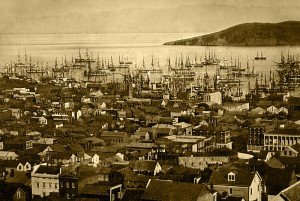
It was time for the Doctor to start the first San Francisco theater. All accounts say that the Doctor was a hit with the miners. He was especially successful with telling jokes about the gold miners and their quest to conquer El Dorado. The Doctor found out that miners enjoyed being joked about and he had them rolling in the aisles. It was escapism and comedy and the miners loved it.
Fires and San Francisco
The Doctor also took in some decent money with his theater. Not long after the Doctor started his little theater, San Francisco was hit by a devastating fire. These fires in 1850 and 1851 came on a regular basis. They also occurred with regularity in the early mining towns in the Sierra Nevada.
During that era, most structures were either made of wood or were simply tents. Fires occurred almost every month or so. Tents and simple structures would be replaced about as fast as they burned up. It was quite incredible how San Francisco and the other towns rebuilt so many times in the 1850’s. Each rebuilding usually was a bit better than what was there before. Some historians contend that the fires in a way improved the San Francisco theater industry and the city in general.

Robinson and Evrard
Yankee Robinson’s second theater was put together with a partner and was called the Robinson and Evrard Museum. While the theater used the word museum, the venue was a theater. At about the same time, a well established gambler by the name of Tom McGuire, also decided that there just might be another way to get miners to part with their gold other than gambling. McGuire owned and operated the Parker House gambling hall and was making a lot of money. He already had women at his gambling hall to help lure men in. Why not have them act on a stage and bring in even more money?
McGuire had also figured out that it might be a good idea to have a second revenue stream. You never knew how long the gambling binge might last. Gold miners who could afford it had no problem catching a steamboat to enjoy the San Francisco live entertainment.
What’s amazing was that the regular fires in San Francisco did not discourage the expansion of the theater industry. In fact, they didn’t seem to discourage anything. Each time a fire would burn the city down, another larger theater would sprout up.
You’ll also enjoy our Trips Into History articles about Nevada City California and Madame Mustache and the Story of Sacramento’s Eagle Theater.
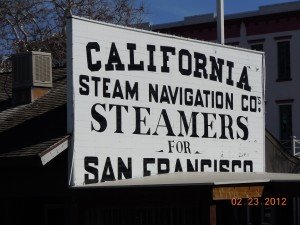
The Theater Battles Between the Doctor and Tom McGuire
Tom McGuire’s theater was named the Jenny Lind. Jenny Lind was a celebrated opera singer from Europe who for whatever reason never did visit San Francisco. In all, McGuire had three different Jenny Lind’s due to the regular fires. The last one was a showplace in 1851 with a capacity of some three thousand. Between the fires and the building of theaters, a competition started up between the Doctor and Tom McGuire.
The competition was for both the miners gold and for the available talent. Each theater owner tried to snag the best performers. As is the case with theater in general, personality flare ups were an occurrence and performers would change venues often. Promotion was very important. Prominent signs and employing barkers at the door to bring in ticket buyers was important. Simple ticket price cutting wasn’t a wise option because the overhead in owning a theater was substantial and the two owners both knew it. Much more overhead than simply running faro or monte tables at a gambling hall.
A funny story told about Yankee Robinson’s third and final theater, the American, had to do with it’s construction. As you might already know, much of the present day San Francisco waterfront area is landfill. In the 1850’s, roads were being formed on the cities sand hills and the sand would be pushed into the bay. As a result, the land area increased along the shore. It just so happened that the Doctor built his theater on just such landfill.
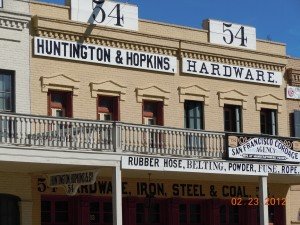
The Doctor built a three thousand seat showplace. It was considered an architectural wonder. His competitor, McGuire and his associates, however didn’t waste any time spreading rumors around town that Robinson’s new American Theater just might be unsafe on all that landfill. Regardless of the rumors, Yankee Robinson’s theater opened up to a full house. While the opening proved successful it was a bit shaky at first. The story is that Robinson’s theater sank some two inches into the landfill while the opening performance was going on.
While it had nothing to do where Yankee Robinson’s American Theater was built, Tom McGuire in the end did win the theater battle. The Doctor went out of business at the end of 1851. Possibly McGuire’s background in the gambling business worked to outsmart the ex drug store owner/ performer/physician. Regardless, the Doctor was finished, bankrupt and actually ended up working for McGuire. The Doctor after all was a performer.
McGuire himself got into some financial trouble in 1852 and as a result of knowing the right people, sold his Jenny Lind Theater to the city fathers for their first city hall. McGuire reportedly got around $200,000 for the building and turned around and opened another theater. Tom McGuire, the gambling hall owner at heart, always seemed to think a step ahead of others.
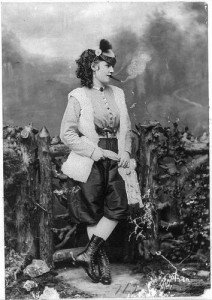
Lotta Crabtree Launches Her Career
An interesting fact is that some very prominent entertainers came out of the California gold mining region. The book, Anybody’s Gold by author Joseph Henry Jackson, gives a lot of detail about some of these performers. The most famous would have been Lotta Crabtree who went on to be the first millionaire entertainer. Lotta was from the east and arrived in California with her mother to join the father who had went in advance searching for gold. His gold efforts went nowhere but his young five year old daughter in the early 1850’s would go on to be a nationally recognized star.
The Times Changed and the Theater Changed
In a way, you could say that what played successful at the theater house ran in direct correlation with the amount of women arriving, respectable women, who inhabited both San Francisco and to a lesser degree the gold camps.
The more wives and relatives who arrived to join the prospectors, the more the atmosphere changed. And many would say for the better. If Shakespeare productions were not popular in 1849, and they weren’t, then they would begin to be as the region became, for lack of a better word, civilized. By the mid 1850’s, churches started to sprout up, schools were being established and a sort of moral standard was evoked. The new residents wouldn’t put up with what the first gold prospectors would. They would complain and complain loudly.
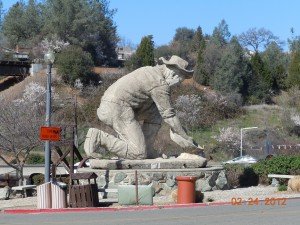
This change wasn’t lost on the gambling hall and theater owners. The early success of Yankee Robinson’s one man act telling jokes about the miners with the accompanying catcalls from the audience declined by about the same rate as women arrived in San Francisco by steamer.
Theater productions, while possibly still performed without rehearsals, took on more serious and classical plot lines. Wild and rowdy show productions weren’t selling like they used to. While there have always been exceptions, plays and monologues that would be acceptable to both male and female audiences were the new money makers.
An Unintended Social Experiment
To demonstrate just how fast the moral atmosphere changed, the state of California in 1855 passed a law forbidding gambling in the state. Obviously, back room games still popped up behind closed curtains. The gambling prohibition also took a bit longer to take hold in the mining camps and villages. The remote locations and the inability to adequately enforce the law made change much slower in the Sierra Nevada foothills.
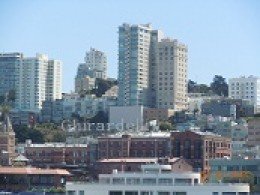
What is interesting is in just how short of a time these significant changes came about. From 1849 to 1855, things almost came full circle. The entire six year span was like a social experiment. The experiment demonstrated what would take place with an almost all male population placed in a remote area without family influences and while on a quest for riches.
It also included the element of no standing moral values. In other words, the prospectors first crude mining camps represented the first civilizing step in building a settlement. The difference with this experiment was that the settlement was being built in the middle of nowhere. Some might say that the 49ers situation was like that of a deployed military unit. The difference however is that a military unit has a chain of command and recognized leaders. There were neither during the first years of the California Gold Rush. I’m certain that many letters sent back home to wives or relatives during the first few years omitted much of the extracurricular activities that went on. Excessive drinking and gambling may have been left out of the letters back home. When the first contingent of respectable females arrived in the gold country, the clock started ticking.
When living conditions and social moors changed, so did the San Francisco theater business. There are many historic theaters in California and several of them make great additions to your California vacation planner.
(Photos of San Francisco harbor and Lotta Crabtree from the public domain. Remaining photos are from author’s collection)
